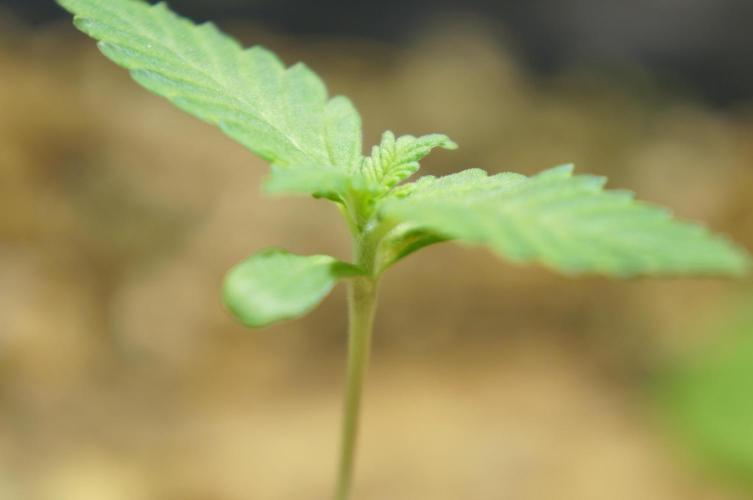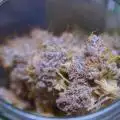The Grow Awards 2026 🏆 










San Fernando Lemon Kush

VEG
CreeCXB3590 Light Emitting Diodes/25W

FLO
CreeCXB3590 Light Emitting Diodes/50W
Soil
Custom
Other
Custom
Indoor
Room Type
10 liters
Pot Size
Start at Harvest
G
Germination1y ago
MalumProhibitum Soaked seed for 1 hour in 0,2%H2O2 enforced with NPK+Mg+1ppm Fe & 1ppm Cl +trace elements. Just enough other minerals to compensate for the abundance of mainly calcium in the tap water used to dilute the 12% H2O2 to 0,2% by diluting it by a factor of 1ml H2O2 12% to 59ml tap water. The final H2O2 NPK-mix had a TDS of roughly 249 ppm.
Moved seed to container with some paper in it, added the H2O2-NPK nutrients and waited 23h before moving seed to soil, while pouring the soak-water on top of the soil over the seed.
Sprinkled the seed with 200+ aztecs to guard the queen..
Cotyledon opened up perfectly and I moved the pot a bit closer to the LED to let the leaves absorb a bit more light.
Adjusted the nutrient mix to invigorate her with a bit more N, as she was a bit pale.
15 likes
3 comments
Share
Used method
Other
Germination Method
2
Week 2. Vegetation1y ago
18 hrs
Light Schedule
28 °C
Day Air Temp
6.5
pH
No Smell
Smell
55 %
Air Humidity
26 °C
Night Air Temp
10 liters
Pot Size
MalumProhibitum OK development, not 100% perfect as the cotyledon is slightly bruised, yet nothing in particular going bad either.
She reminds me of another strain from sweet seeds I cultivated few months ago - red hot cookies, very symmetric and vigorius growth!
No further comments, she is doing allright I think :)
--
I synthesized dilute nitric acid (HNO₃) due to restrictions, which I commonly use for pH adjustments. I avoided using phosphoric acid (H₃PO₄), given its tendency to precipitate various soil ions, preferring instead to derive phosphorus from potassium hydrogen phosphate (K₂HPO₄).
With access to hydrochloric acid (HCl) and calcium nitrate (Ca(NO₃)₂), I utilized a closed-loop gas recirculation system with copper as a catalyst to generate HNO₃. The system included a triple-barrier setup with diluted hydrogen peroxide (H₂O₂) to absorb nitrogen dioxide (NO₂) and nitrogen tetroxide (N₂O₄) gases, thus converting Ca(NO₃)₂ to HNO₃ without venting any gases. This controlled approach minimized exposure to toxic NOx fumes, which are both harmful and wasteful if released.
Once gas absorption was complete, I titrated a known volume of potassium hydroxide (KOH) to verify the concentration of the resulting nitric acid. I then diluted the acid to approximately 2% HNO₃, as this concentration reduces the risk of skin irritation and staining upon accidental contact, compared to the hazards of 69% or fuming nitric acid. Even if 3% conc is still legal w/o papers in most of EU I felt 1-2% was more my to my taste and in line with the 1% HCL and 0,75% phosphoric acid used as pH-.
Added 2 ml of ~2% HNO₃ (0.3 M) to the 1400 ml nutrient solution to lower pH from 6.8 to 6.5 while providing additional nitrogen for improved seedling vigor. HNO₃ was selected over H₂SO₄, H₃PO₄, or HCl due to its dual function: it supplies bioavailable nitrogen and effectively solubilizes calcium into Ca(NO₃)₂, enhancing root uptake, whereas H₃PO₄ would risk forming insoluble calcium phosphate.
---
To regenerate pure copper from the catalyst, I utilized the aluminum from two empty Red Bull cans as a cost-effective alternative to expensive aluminum foil. I first added the aluminum to the copper chloride (CuCl) slurry, facilitating its conversion to aluminum chloride (AlCl₃).
After the conversion, I rinsed the mixture with water to dissolve the aluminum chloride, allowing the copper to be washed out. The copper was then filtered from the solution.
Next, I heated the resulting liquid, allowing the gases released during the process to bubble through a vessel filled with ice water. This setup effectively condensed the vapor, facilitating the recovery of hydrochloric acid (HCl).
Finally, I distilled the collected HCl to reclaim the original reagents. Throughout this procedure, the only resources lost were inexpensive Ca(NO₃)₂ + thermal energy and time, indicating a high efficiency in material recovery & no harm to the environment. Same logic as with recovering soil from the previous grow to keep a low profile and reduce the eco footprint. Same soil used since 2016, increasing in volume for every year as I keep recycling/composting the leftover leaves, stems, and root-systems over and over from previous grows.
---
14 likes
2 comments
Share
3
Week 3. Vegetation1y ago
18 hrs
Light Schedule
28 °C
Day Air Temp
6.5
pH
No Smell
Smell
55 %
Air Humidity
26 °C
Night Air Temp
10 liters
Pot Size
MalumProhibitum I have decided to flip the plants to 12/12 next week.
Exceptional development and the fact I won't have room/light enough if they expand much further FLOWER it is!
Given how much they have both grown so far I rather flip now and get a little feisty bushy plant.
As the other plants need room too, and I have no room to spare as all plants in the grow-space, earned their spot and has a special place in my heart by now, surviving my ordeals and sub-optimal grow-conditions and challenges; withstanding my trials, where 1-2 plants come out as winners, while the husks of their competitors are still decaying in the soil they are growing in.
I also hate trimming. More than 50g and I get a panic feeling in my body, and just want to throw it all in the freezer for later, or rurn it into BHO. I cannot handle extracts well, it gets overwhelming quickly xD
13 likes
comments
Share
4
Week 4. Flowering1y ago
12 hrs
Light Schedule
28 °C
Day Air Temp
6.5
pH
Weak
Smell
55 %
Air Humidity
26 °C
Night Air Temp
10 liters
Pot Size
MalumProhibitum First week 12/12 flower, very little smell and no pre-flowers yet..
17 likes
5 comments
Share
5
Week 5. Flowering1y ago
12 hrs
Light Schedule
28 °C
Day Air Temp
6.5
pH
Normal
Smell
55 %
Air Humidity
26 °C
Night Air Temp
10 liters
Pot Size
MalumProhibitum Pre-flowers developing though I think the flip @week 2 veg, week 3 total didn't make much difference, she is still a big baby.
She is spreading a subtle but pleasant scent of cofee mixed with citrusy, herbal notes already, but I suspect I'll get a more musky grow-fragrance once she has matured more.
14 likes
comments
Share
6
Week 6. Flowering1y ago
12 hrs
Light Schedule
26 °C
Day Air Temp
6.5
pH
Normal
Smell
55 %
Air Humidity
24 °C
Night Air Temp
10 liters
Pot Size
MalumProhibitum Apart from my nutrient mix being a little bit too strong it has been another uneventful week! I will cut back some on the nitric acid and replace it with phosphoric acid and increase micro+trace elements a notch.
Shifted the pots- position with future#1 to get a more even distribution of light on the sides of the plant.
The plants has taken on a musky smell and flowers are taking shape, developing into dense balls of fluffy light-green goodness!
I'm not sure if the flip to 12/12 light after 3 weeks was working, as both plants keeps expanding still. Hopefully they slow down now, as the grow-space looks more and more over-populated. The plants are currently growing outside the grow-area and getting a bit limited light from the mail light source, but get backup light from the side, where I shift the plants every other day to give them both 3,5 days / week of direct LED-light.
14 likes
2 comments
Share
7
Week 7. Flowering1y ago
12 hrs
Light Schedule
26 °C
Day Air Temp
6.5
pH
Normal
Smell
55 %
Air Humidity
24 °C
Night Air Temp
10 liters
Pot Size
MalumProhibitum Both plants are transitioning at a sub-optimal pace, slightly inhibited by lack of phosphorus in the soil, slight excess of nitrogen and lack of space & light.
As the pH in the run-off was 7,2 I added one tablespoon phosphoric acid 0,75% to the 5 liter nutrient reservoir before adding 1liter/plant of said mix, enforced with just a pinch of KH₂PO₄. Then I disgarded the runoff and will now observe any changes on the fan-leaves to see if the correction has had the intended effect.
Sweet- citrusy notes comes off of her, as she is recieving less light than her room mate at the moment it's very subtle.
The development is slower than for example when I did the dedicated grow of just DosSiDos33, where it's just one plant taking up the grow-space instead of like now when 2 dedicated plants has to compete with 12 pots; filled to the brim with chili, tobacco plants, thyme and oregano. So instead of 100% grow-ligts directed at one plant I now estimate one plant get roughly 1/4 at best to 1/12 of the light in the grow-space.
14 likes
comments
Share
8
Week 8. Flowering1y ago
12 hrs
Light Schedule
26 °C
Day Air Temp
6.5
pH
Normal
Smell
55 %
Air Humidity
24 °C
Night Air Temp
10 liters
Pot Size
MalumProhibitum Nothing special this week, just giving it some water..
She gives off a sweet scent with lingering citrusy notes and a hint of strawberries.
13 likes
comments
Share
9
Week 9. Flowering1y ago
12 hrs
Light Schedule
26 °C
Day Air Temp
6.5
pH
Strong
Smell
55 %
Air Humidity
24 °C
Night Air Temp
10 liters
Pot Size
Nutrients 1
10 mll
MalumProhibitum She is giving off a strong sweet smell, with subtle hints of strawberry & citrusy goodness! (top-smell, if not the best smell I've ever encountered when it comes to fruity & delicious flavours!).
12 likes
comments
Share
10
Week 10. Flowering1y ago
12 hrs
Light Schedule
26 °C
Day Air Temp
6.5
pH
Strong
Smell
55 %
Air Humidity
24 °C
Night Air Temp
10 liters
Pot Size
Nutrients 1
10 mll
MalumProhibitum I was finally harvesting some chiliplants, and could remove the plants and leave room for the GD plants to get some more light.. upgraded from 2 plants sharing 50W to 200W. As I havn't defoliated, or removed anything both plants has a lot of bud sites in need of maturing 😅. She is absorbing the nutrients like a sponge, and I might need to cut back some more on the nitrogen to get a nice fade before it's time to harvest.
The scent has taken on a deeper citrusy/strawberry-sour candy scent; loveit! 👊😍👌 --Mmmm!
By the looks of things I'd estimate she needs ~21 more days to fully mature, maybe even more. She has suffered some from low-light conditions, so this will be a good test for her to see if I can push the time to harvest to get fat nugs before she starts producing 🍌... 😅. I might even push the weks to force her to develop male flowers to get few seeds off her and x-pollinate the Future#1 as I'm extremely happy with both plants and a little bastard baby-cross would be kinda awesome haha.
15 likes
comments
Share
11
Week 11. Flowering1y ago
12 hrs
Light Schedule
26 °C
Day Air Temp
6.5
pH
Strong
Smell
55 %
Air Humidity
24 °C
Night Air Temp
10 liters
Pot Size
Nutrients 1
10 mll
MalumProhibitum She needs more light! I'm not sure if it's just the light or due to me using the same mix of nutrients for all the plants for a while, where this one has responded worse to the high micro-elements added as well as absorbing more of the added nitrogen, but the smell makes up for that. She is giving off a strong fruit/berries sour-strawberry-lemon-sweetness I have never experienced in a grow before. As I see no amber yet I'll just keep pushing her to harvest, and keep trying to find a nutrient-mix that works better for the next grow as this one is a keeper!
She has the potential, but I need to get to know this strain better and I will 😍. As the grow is nearing harvest I'll get some pots ready to do another round + red-hot-cookies grow; hoping to find a deep-red phoeno and explore 2 more strains from sweet seeds - Purple punch & Gorilla girl! 😘.
I have put her on a heavy P-K diet, reinforced with CalMag, completely void of N; Even if I cannot get a perfect fade before harvestg I'm hoping the deeper green will transform into light green or even yellow tones before harvest!
I want to pinch off some popcorn bud and smoke her r.n, but at the same time I want to maxxx harvest and not stress her either. 10-25% amber -- chop! My guess is 2-3 more weeks.
50W for this big lady plus some passive LED light from the main grow is a bit on the lower end.. Hopefully I get some good swelling now when she recieves 100W.
14 likes
comments
Share
12
Week 12. Flowering1y ago
12 hrs
Light Schedule
26 °C
Day Air Temp
6.5
pH
Strong
Smell
55 %
Air Humidity
24 °C
Night Air Temp
10 liters
Pot Size
Nutrients 1
Aqua nutes
10 mll
MalumProhibitum She is still giving off that lovely strawberry & sour lemon-candy smell and I loveit!
As the trichomes are still mostly clear or cloudy and barely any amber yet I'll keep feeding her reinfrced P+K for another week; a sprinkle KH₂PO₄ and some CalMag and water on top of that.
15 likes
4 comments
Share
13
Week 13. Flowering1y ago
12 hrs
Light Schedule
26 °C
Day Air Temp
6.5
pH
Strong
Smell
55 %
Air Humidity
24 °C
Night Air Temp
10 liters
Pot Size
Nutrients 2
Aqua nutes
10 mll
Nitric acid 2%
1 mll
MalumProhibitum She is still producing flowers and very little to no amber so I'll just keep feeding her and observe!
As she didn't drink as much this week I decided to lower the TDS, while still giving her high P-K nutrients with a few drops 2% nitric acid, just enough to keep the runoff pH @~6,8; TDS@666!
I pinched off a little popcorn bud at the bottom of the plant and vaped it. The taste was delicious even though the bud was fresh from the plant, with subtle strawberry and lemony notes intertwined with a hint of delicious newly served french fries!?! A mellow taste, hiding it's potency.. smooth a.f, but it is a creeper, and just as I started feeling giggly I was already too high to stand up w/o feeling I was going to faint. I ended up in bed soon after, sleeping like a baby. It was one of those abrupt sleeps, where I didnt have time to turn off the TV, the lights or even take off my clothes, just hit bed, hug pillow; sleep.
15 likes
comments
Share
14
Week 14. Harvest1y ago
Happy Harvest Day!

10/10
Rated
The grow has finally reached the harvest week. It has been a treat to tend to her from start to finish; top quality from delivery to harvest!
During early to mid flower her strawberry scent was extraordinary, but she lost some of that strawberry sweetness, being replaced with a more musky/pungent smell during the final week up to harvest as I pushed her to produce more dense & frosty buds. I could have harvested her a bit earlier and kept the temps a bit lower to preserve that fruitiness, but I wanted to make sure the flowers were more mature. Week 11 was her prime in terms of sweet fruitiness but week 12 felt better! It gave her a little bit more time to fade and develop more dense nugs! xD I still quite didn't get the fade I was after, but as I had 4x vegged plants ready for flip I got a bit short on time, and there is that :/ One more week would have been perfect!
She was very easy to trim, as she didn't develop many leaves during flower. It was pretty much just flowers on top of flowers, fat kushy buds; ready to be dropped into the curing-jars.
Show more
Translate
Spent 86 days
Ger Veg Flo Har
480 g
Bud wet weight per plant
93 g
Bud dry weight per plant
1
Plants
0.25 m²
Grow Room size
Easy
Difficulty

Happy, Giggly, Euphoric
Positive effects

Dry mouth
Negative effects

Stress, Insomnia
Medical effects

Herbs, Woody, Diesel
Taste
Day air temperature
Air humidity
PH
Light schedule
Night air temperature
Pot size
MalumProhibitum BOOM!
18 likes
2 comments
Share

the end.
Enjoying this diary? Follow for more updates!
Prefer the old Diary view?
Go back to the old Diary view

























































